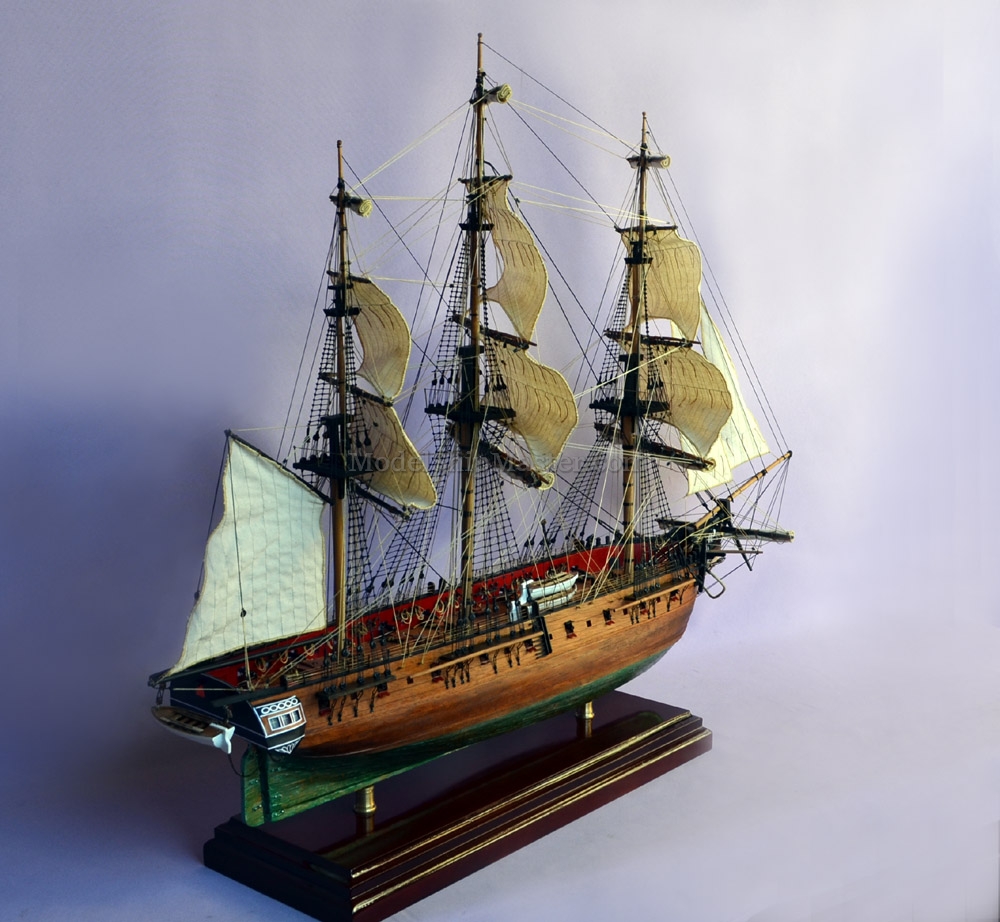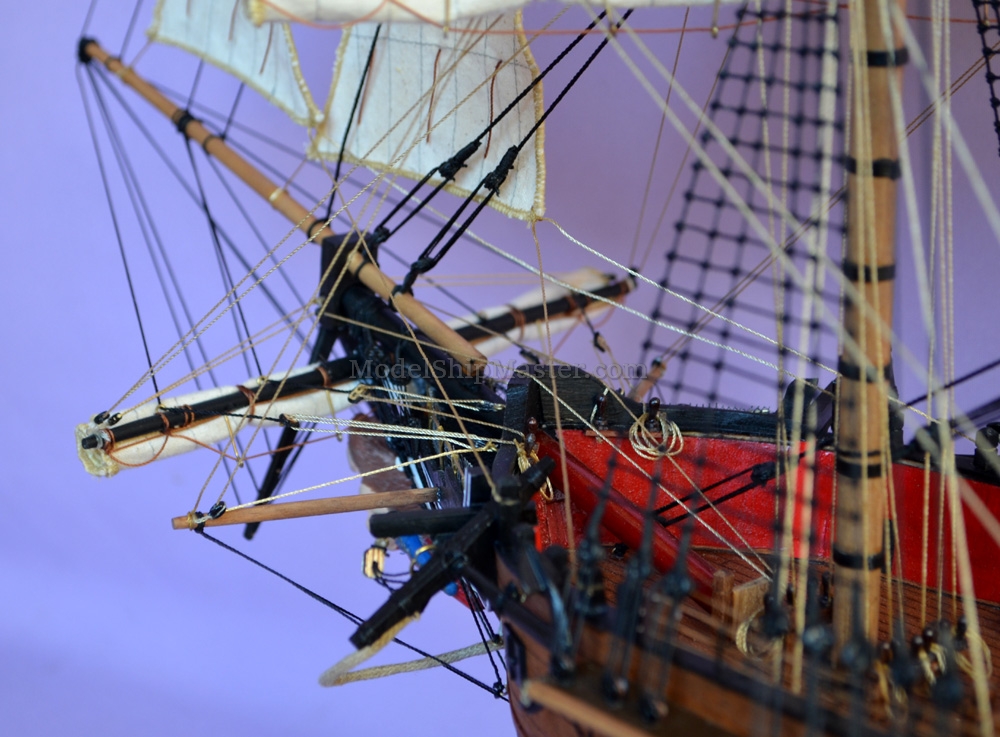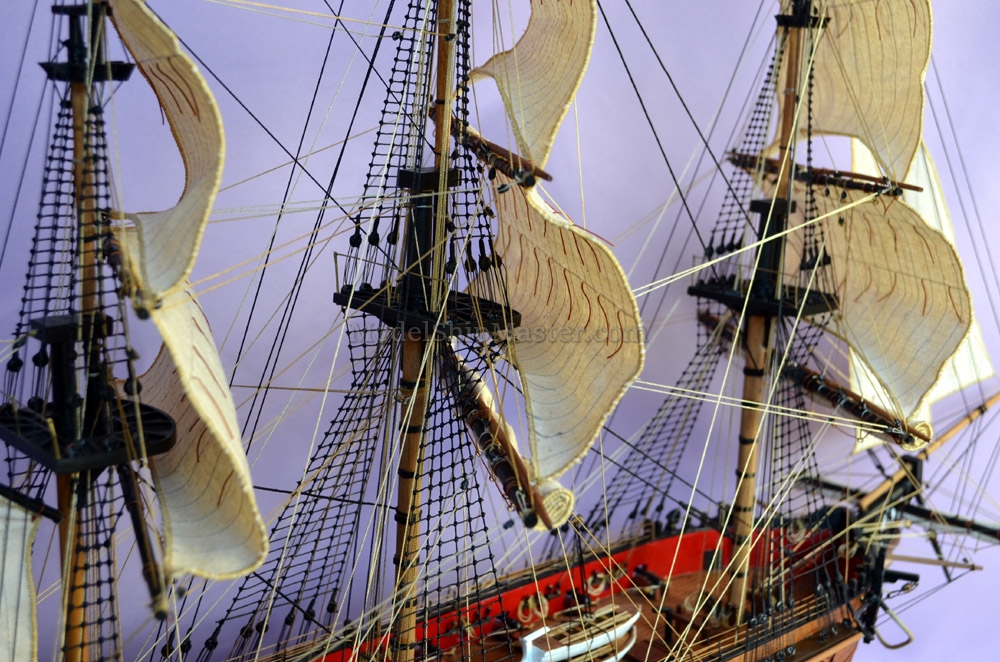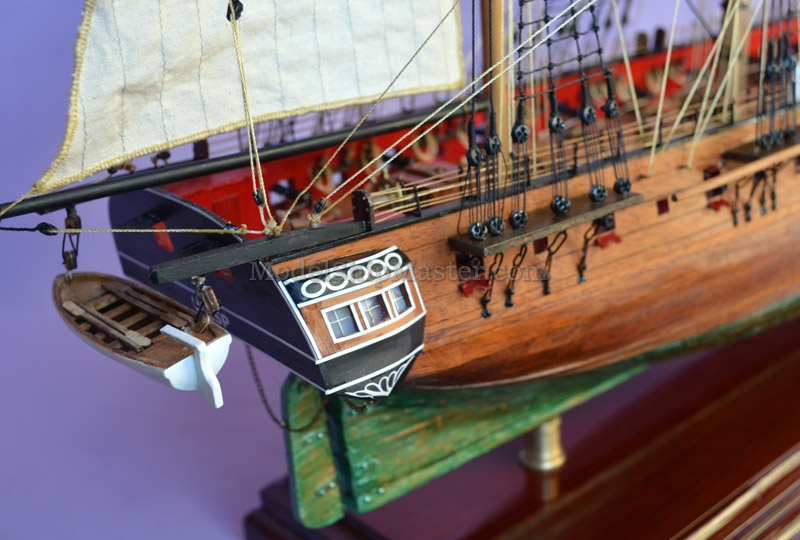|


256-bit encryption
$500,000 protection

|
USS WASP (1814)
USS Wasp was one of three sloops-of-war ordered by
Secretary of the Navy, William Jones, in June of
1813. Wasp and two sister ships -Peacock, and Frolic
were all put to sea in June of 1814. The Frolic was
captured straight off by two British ships, but the
Peacock and Wasp went off to raise havoc with
British shipping, capturing or burning between them
34 ships, 16 for the Wasp. At the same time
the Wasp engaged and defeated two British brigs, the
HMS Reindeer and the HMS Avon in June and September
1814.
No
vessel and no captain did more damage gun-for-gun and
ton-for-ton to the Royal Navy and British merchant
shipping than the U.S. sloop-of-war Wasp.

117' in length, the USS Wasp
was a fast moving
sloop-of-war.
She
carried 173 officers and enlisted men.
That crew was made up of almost entirely New Englanders
of averaging only 23 years of age. Many of them had not
previously been to sea, and it would take a skilled and
talented man to lead this enthusiasm and ambition crew.
Wasp's first and only commander was thirty-three year
old, Irish born, Master Commandant Johnston Blakeley who
had already earned his place in naval history,
commanding the USS Enterprise in the splendid victory
over the HMS Boxer.

About the
USS Wasp
model:
- Built from scratch over
hundreds of hours by master artisans
- Double
plank-on-frame
construction
-
Copper-plated bottom:
individual copper pieces that were weathered unevenly to
create a realistic look (no shiny copper paint, no fake lines.)
-
Blackened metal cannons and wooden carriage.
Under the main deck, all guns are "real" guns which
have proper barrels and wooden carriages which sit on 2
real decks under the main deck. These
guns are not simple barrels inserted into a solid hull
like in a cheap model.
- Authentic Extensive rigging system comprised of many
different sizes of rope and features numerous blocks and
deadeyes
.jpg)
First
raiding voyage in the English Channel:
USS Wasp captured her first vessel, the 207-ton barque Neptune,
on 2 June 1814, embarked her crew as prisoners, and
burned the prize at sea. On 13 June 1814, she took and
burned William, a 91-ton brig. On 18 June 1814,
Wasp captured and scuttled the 131-ton armed
brig Pallas. Her fourth victim, 171-ton galiot Henrietta,
which she took on 23 June 1814, was given to the
prisoners Wasp had thus far taken. On 26 June
1814, Wasp captured and scuttled her largest ship so
far--the 325-ton ship Orange Boven.
When
Johnston Blakeley took a risk to hunt
farther up the Channel than had been intended,
Wasp came upon formidable opponent some 225 miles west
of Plymouth, England on 28 June 1814. It was the
18-gun HMS Reindeer.
After
two hours of engaging in a cat-and-mouse standoff and a
bit of a chase between the two ships, it was the Reindeer that
fired the first 12 pound cannonade. The USS
Wasp only
returned fire, in succession, with all the guns of his
broadside. The Reindeer could
not bear that kind of thunderous blow and became somehow
disabled and run aboard of the Wasp.
With
Reindeer's
port bow against the Wasp’s quarter,
the Wasp's
32-pounder carronades
started to crumble her opponent.
On
deck, masts and spars, American marines and riflemen
with the remarkable marksmanship were in action.
The captain of the Reindeer was
among the wounded but refused to back down and a second
bullet went through his thigh and brought him to his
knees. Bleeding profusely, and shouted to his men:
"Follow me, my boys, we must board.” But two balls
from the Wasp’s maintop
instantly passed through his skull. Commander Blakeley
would later write: “The Reindeer was literally cut to
pieces in a line with her ports.”
During the brief 19-minute fight. USS Wasp suffered
six hits in her hull, and some of her rigging was shot
away, but she remained sailable.
The USS Wasp
lost five and twenty-one were wounded
while
25 men of
Reindeer were killed and 42 wounded.
After taking prisoners on board, setting fire to
Reindeer, and watching her explode, USS Wasp set course for L'Orient, France to care for her wounded men. En
route, she took two more prizes, the 112-ton brig
Regulator on 4 July 1814 and the 151-ton schooner Jenny
on 6 July 1814.
Second raiding voyage:
USS
Wasp remained in L'Orient until she again put to sea on
27 August 1814. On 30 August 1814, she captured
the brig Lettice and, on 31 August 1814, took another,
Bon Accord. Early in the morning of 1 September
1814, she encountered a convoy of 10 ships escorted by
the 74-gun ship-of-the-line HMS Armada. Wasp
bravely singled out the brig Mary, which she quickly
took as a prize, carrying off Mary's crew as prisoners
and burning her. The American sloop then attempted
to take another ship in the convoy, but the Armada
chased her off.
That evening, she spied another
sail on the horizon and gave chase. By 21:30, she
had the brig under her lee bow and opened fire.
The enemy returned fire until 22:00 at which time her
battery seemed to cease fire. When Wasp did the same and
called for the stranger's surrender, the British ship
answered with another cannonade. Wasp again opened
fire on the ship, now known to have been the 18-gun,
391-ton brig HMS Avon. Some broadsides later,
Avon's guns fell silent once more, and Wasp repeated the
call for surrender. Avon, at this point a battered hulk,
had no choice but to comply.
However, just as
USS
Wasp began to lower the boat for the
prize crew, the lookout sighted another enemy brig
standing toward the two adversaries. Wasp's crew manned
their battle stations immediately in hope of taking the
newcomer as well. Just then, two more British
ships appeared on the horizon and Wasp was forced to
give up the destruction of Avon and see to her own
salvation. The lead British ship, however, failed
to engage Wasp; instead, she hauled in close to Wasp's
stern and loosed a broadside into the American's rigging
which damaged sails, sheets, and braces considerably and
then came about to rendezvous with the other two ships
following her and the sinking Avon. Although the
Americans didn't know it at the time, Avon sank soon
after Wasp left her. Avon had suffered 10 killed
and 32 wounded. Avon's primary rescuer was her
sister ship, Castilian.
The USS Wasp continued her ravages of the British
merchant marine. On 12 September 1814, she
encountered Three Brothers, a brig, and scuttled her.
On 14 September 1814, she sank the brig Bacchus. On 21
September 1814, an eight-gun brig Atalanta, ran afoul of
Wasp, and she, too, suffered the ignominy of capture.
Deeming Atalanta too valuable to destroy, Blakeley
placed her under the command of Midshipman David
Geisinger and sent her to the United States. She
entered Savannah, Georgia safely on 4 November 1814.
After USS Wasp
and Atalanta parted company, nothing more was heard from
Wasp. She was last seen by a Swedish merchantman
bound from Rio de Janeiro to Falmouth, England, about
three weeks after the Atalanta capture and was said to
be headed for the Caribbean. Wasp probably foundered in
a storm.

|
Dimensions and price of this USS Wasp
model:
This
33" long x 27"
tall x 11" wide
$4,695 Shipping and
insurance in the contiguous US included. Other
places: $500 flat rate.
Model is built per commission only. We require only
a small deposit (not full amount, not even half) to start the process.
Click on this link for
lead time.
Illuminate the model in a
special occasion, dimly lit room:
$300. Powered by a
standard 9v battery hidden under the base for your
convenience.

"The Wasp arrived in good order, safe and sound.
The model is one of your best productions with
detail as authentic as you can get. It now has a
place our honor in my den. It just so happens that I
have a copy of the actual ships plans from the
National Archives and the model is remarkably
accurate. I'm grateful for such a great job. I
couldn't be more pleased.
Best regards,
Michael T.
Rio Rico, AZ"

Learn more about the
sloop of war USS Wasp here:
https://en.wikipedia.org/wiki/USS_Wasp_(1814)
|
|